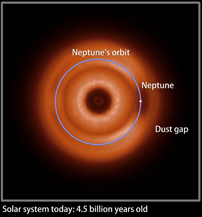Archive
The Biggest Computer Monitor You'll Ever See in Your Life
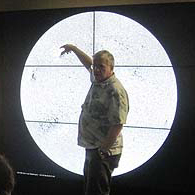 Explore@NASA Goddard Day this past Sunday was a huge success, with an estimated 15,000 people coming to Goddard Space Flight Center to meet astronauts, tour the facilities we use to build and test spacecraft, and — on my end of the campus — see the biggest computer monitor you can imagine.
Explore@NASA Goddard Day this past Sunday was a huge success, with an estimated 15,000 people coming to Goddard Space Flight Center to meet astronauts, tour the facilities we use to build and test spacecraft, and — on my end of the campus — see the biggest computer monitor you can imagine.
They call it the hyperwall. It’s a bank of HD monitors banked together to create a huge viewing surface to observe and discuss scientific data and visualizations. It consists of fifteen 46-inch high-definition LCD screens — five across, three high — to create a combined 17-by-6 foot surface. The visualization wall displays both high-definition movies of computer simulation results and interactive data visualizations.
The wall can display a single visualization across all 15 screens or up to 15 or more different visualizations at once for comparison. (No, we don’t sneak in after hours to watch Star Wars or play video games.)
Like hundreds of my colleagues, I was pitching in to Explore@NASA Goddard Day. Mission: meet, greet, and guide people to the hyperwall. Below are a few photos I snapped between helping visitors.
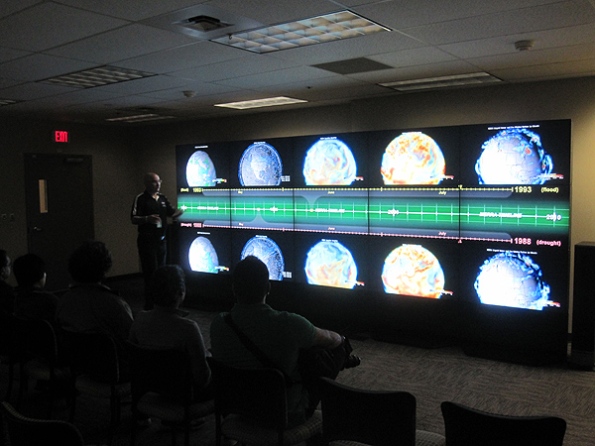
Phil Webster (above left), chief of the NASA Center for Climate Simulation, explains how NCCS research and technology helps scientists and meteorologists. (NCCS built and operates the hyperwall.)
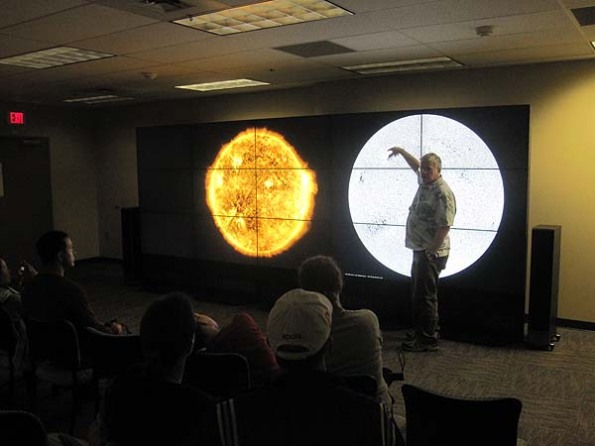
Horace Mitchell (above right) is the Director of the crack team of scientists, animators, and artists in Goddard’s Scientific Visualization Studio. They make stunning images and movies from actual data collected by NASA spacecraft of Earth and the wider universe.
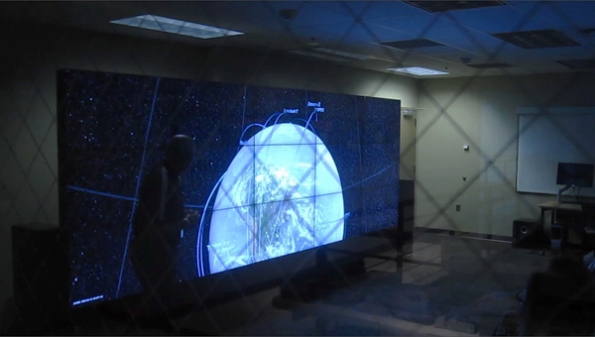
Polar-orbiting satellites swoop over a glowing HD Earth on the hyperwall during the presentations for Explore@NASA Goddard Day.
_____________________________________________________________________________________________________
OH AND DID I MENTION? All opinions and opinionlike objects in this blog are mine alone and NOT those of NASA or Goddard Space Flight Center. And while we’re at it, links to websites posted on this blog do not imply endorsement of those websites by NASA.
w3counter(39986);
Gogblogcast #5: Marc Kuchner and the Search for Other Earths
Marc Kuchner is an astrophysicist at Goddard Space Flight Center who studies planetary systems around other stars. As he explains in this video, the trouble is that when you point a telescope — even one as powerful as the Hubble Space Telescope — at a star with a planetary system, you can’t see the actual planets very clearly. At best you see a glowing dot.
But what you CAN see very clearly is the thin dusty disk that occupies a vast volume of space around the star. Our solar system has one, too: It’s called the zodiacal cloud.
Marc and his students — most notably, Christopher Stark, now at the Carnegie Institution for Science in Washington, D.C. — have developed computer simulations of planetary dust. This is what the simulations show: Although it may be some time before we have a space telescope powerful enough to directly image the face of an alien planet, we should be able to detect the presence of planets by the effects they have on dusty disks. Most likely those planetary telltales will be structures such as rings and dimples.
Want to know more about dust simulations? See a previous gogblog post and the computer visualization below for the details.
By the way, when Marc mentions during the interview that there are “about 400 planets known,” it was accurate. But since this interview was recorded, the count has risen to 500!
_____________________________________________________________________________________________________
OH AND DID I MENTION? All opinions and opinionlike objects in this blog are mine alone and NOT those of NASA or Goddard Space Flight Center. And while we’re at it, links to websites posted on this blog do not imply endorsement of those websites by NASA.
w3counter(39986);
Bodies in motion: a computer modeling trick developed at Goddard allows us to simulate what our solar system looks like to aliens
A few years ago, a University of Maryland graduate student, Christopher Stark, crossed paths with NASA astrophysicist Marc Kuchner. “He landed in my office and asked me if I had any projects,” Kuchner recalls.
Stark needed to do some interesting and original science so he could become a professional scientist instead of a professional student; Kuchner needed help with his interesting and original research on how planets sculpt the disks of dust and gas in alien star systems, creating features like rings, gaps, and clumps.
And maybe, just maybe, by imaging those rings, gaps, and clumps in disks of dust around alien star systems, we might be able to discover planets. In other words, we might find planets by spotting their gravitational pull on their surroundings, as opposed to taking a picture of the actual planets, which is a rare and delicate trick.
http://www.youtube.com/v/BYQZRgWwXgQ?fs=1&hl=en_US
New model
Fast forward to summer 2010. Stark finishes his PhD thesis on computer modeling of dust disks around alien stars, gets a sweet job at Carnegie Institution for Science in Washington, D.C., and is the lead author on a paper describing aforementioned interesting and original science in the September 7, 2010, Astronomical Journal. Life is good!
Read the Goddard Space Flight Center press release and video for the science details. Stark and Kuchner basically simulated the dust in our own solar system and showed what it would look like to alien astronomers observing from afar. (Hint: they can see a ring-shaped collection of dust with a gap due to the influence of Neptune.)
Here, let’s talk about how Stark and Kuchner simulated dusty solar systems in the supercomputer down the hall from me.
The “debris disks” around stars contain an unimaginable number of tiny grains of dust — “dust” being tiny clots of crusty minerals and frozen vapors. Fluffy interplanetary dust bunnies, really.
As planets orbit, their gravity can induce rings and clumps in the dust. And because warm interplanetary dust radiates infrared energy, telescopes trillions of miles away can actually SEE the rings and clumps even though they can’t see the planets creating them.
Kuchner and Stark decided to build a more realistic computer simulation of dusty disks with planets. It could prove a pretty handy tool for spotting planets someday.
The problem: too many dust bunnies! Getting a computer to track the movements and interactions of so many bits of stuff is, well, practically impossible.
Ever heard of the “three body problem”? For physicists of olde like Sir Isaac Newton, calculating the motions of three gravitating bodies in free space was enough to induce cardiac arrest. Dauntingly, terrifyingly, slide-rule-breakingly hard.
“How,” Kuchner asks, “do you figure out the answer without having to figure out a billion billion billion collisions?”
Stalking dust bunnies
Tracking a billion billion billion dust bunnies is not even worth considering, even with the formidable computing resources down the hall from me at Goddard, that being the Discover supercomputer.
But Stark and Kuchner found a way. They call it the collisional grooming algorithm.
An algorithm is a precise set of mathematical rules that describes how to solve a problem. Stark and Kuchner used it to simulate 75,000 virtual dust particles and track their motions and number in response to grain-grain collisions and the gravitational tug of planets.
But what about all the other dust bunnies, the billion-billion-billion?
“We allow each single integrated particle to represent many dust grains,” Stark explains. “We scale the number of dust grains up and down to control how much dust is in the disk, even though we only actually integrate 75,000 particles.”
But let nobody leave the room thinking that approximating the behavior of 10 billion billion billion dust bunnies is easy.
At Goddard, we have a supercomputer called Discover. The thingies that do the actual data processing in a computer are called processors, and Discover presently has about 15,000 of them. That’s the number of processors in 7,500 MacBook Pro laptops like the one I used to write this blog post. Which is to say, my laptop packs an Intel Core Duo, or two processors, whereas the Discover supercomputer packs about 15,000 processors. Soon, Discover will double in capacity to nearly 30,000 processors.
To run Stark and Kuchner’s interplanetary dust bunny simulation required about 3,000 processors — the equivalent of 1,500 MacBook Pro’s — running for 24 hours!
_____________________________________________________________________________________________________
OH AND DID I MENTION? All opinions and opinionlike objects in this blog are mine alone and NOT those of NASA or Goddard Space Flight Center. And while we’re at it, links to websites posted on this blog do not imply endorsement of those websites by NASA.
//
</p> <div><a href=”http://www.w3counter.com” mce_href=”http://www.w3counter.com”><img src=”http://w3counter.com/tracker.php?id=39986″ mce_src=”http://w3counter.com/tracker.php?id=39986″ style=”border: 0″ mce_style=”border: 0″ alt=”W3Counter” /></a></div> <p>
